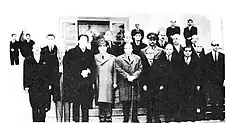Asadollah Sanii | |
|---|---|
| Minister of War | |
| Monarch | Mohammad Reza Pahlavi |
| Prime Minister | Hassan Ali Mansur Amir-Abbas Hoveyda |
| Preceded by | Ali-Asghar Naghdi |
| Succeeded by | Reza Azimi |
| Personal details | |
| Born | 1904 |
| Died | August 14, 1998 (aged 93–94) Vancouver, Canada |
| Nationality | Iranian |
| Spouse | Turandokht Parvini |
| Children | 4 (Bahman, Bijan, Maryam and Jaleh) |
| Alma mater | Officers' School |
| Military service | |
| Branch/service | Imperial Iranian Army |
| Rank | Lieutenant general (Sepahbod) |
| Commands | Deputy Minister of War Minister of War |
Asadollah Sanii (1904–1998) was the Iranian minister of defense in the 1965 cabinet of prime minister Amir-Abbas Hoveyda.[1]
Background

Asadollah Sanii was born in 1904 in Hamedan. His father, Mirza Aga Khan, son of Agha Rashid. Among the Aga Khan's sons, only Asadullah - the first child in the family - chose the surname Sani, while his other brothers and sisters chose Rashidi's fame. Sanii married Turandokht Parvini, and raised four children: Bahman, Bijan, Maryam and Jaleh.
Occupations

Sani entered the army in 1926 and graduated from officer college in 1928. In the years before the 1953 coup d'état, the industrial jobs are as follows: Head of the complaints department of the Shah's military office (at the beginning of the reign of Mohammad Reza Pahlavi), head of the inspection of the conscription department, member of the supervisory board of Sepeh Bank and inspector of Sepeh Bank, first class financial inspector. Administration, General Inspection of the Army and Deputy Ministry of National Defense in the government of Dr. Mohammad Mossadegh.
From 1953 to 1961, Sanii held important financial positions such as the managing director of the Army Consumption Cooperative Company, the head of the army command department (General Army Procurement Department - Atka) and the chairmanship of the board of directors of the consumption cooperative organization of the police forces and the Minister of War.[2]
Affiliations
While Asadollah Sanii was a follower of the Baháʼí faith, when he was appointed Minister of Defence, the Baháʼí community of Iran expelled him from that community — as Baháʼís are prohibited from involvement in partisan politics — the public, however, still continued to associate him with his previous religion.[3][4][5]
The majority of prominent people in political positions under Mohammad Reza Shah’s rule, usually mentioned as Baha’is in the narrative of the Islamic Republic, were not Baha’is. Some came from Baha’i families or had Baha’i ancestors, but never identified themselves with the religion, and even openly expressed their allegiance to Islam.[4][5]
External links
 Media related to Asadollah Sanii at Wikimedia Commons
Media related to Asadollah Sanii at Wikimedia Commons
Notes
- ↑ Steinberg 2016.
- ↑ Fardoust, Hossein, The Rise and Fall of the Pahlavi Monarchy, pp. 266-465.
- ↑ Chehabi 2008, pp. 186–191.
- 1 2 Yazdani 2017.
- 1 2 Brookshaw & Fazel 2008.
References
- Steinberg, ed. (2016). The Statesman's Year-Book 1966-67. London: Palgrave Macmillan. p. 1136. ISBN 978-0-230-27095-4.
- Chehabi, H.E. (2008), "Anatomy of Prejudice", in Brookshaw, Dominic P.; Fazel, Seena B. (eds.), The Baha'is of Iran: Socio-historical studies, New York, NY: Routledge, ISBN 978-0-203-00280-3
- Brookshaw; Fazel (2008). The Baha'is of Iran : socio-historical studies. London: Routledge. pp. 186–191. ISBN 0-415-35673-3. OCLC 81945288.
- Yazdani, Mina (2017). "Towards a History of Iran's Baha'i Community During the Reign of Mohammad Reza Shah, 1941-1979". Iran Namag (Spring ed.). 2 (1): 66–93.